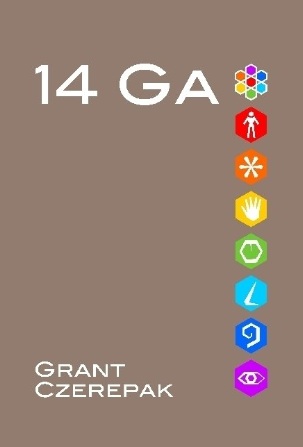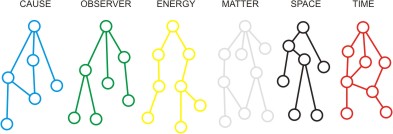
“Tao can Tao not Tao”
Lao Tzu
Since reading the work of Clare W. Graves of Spiral Dynamics fame, reflecting on the work of all the people mentioned in my Blogroll as well as my recent foray into Zen I attempted to review and revise my work on the assortment of frameworks I had come up with. As I was making revisions it dawned on me that nature had done all the work already.

“Outside this office, Business as Usual;
Inside this office, Thunder and Lightning.”
Colonel John Boyd
I decided to take another angle of attack. I realized I was dealing with entities, hierarchies, attributes and relationships and one thing Boyd overlooked, results, in two dimensions not one. You may remember this graphic:

I realized I would have to take the Boyd Pyramid a bit more seriously. And I have. I compared Boyd’s work to Einstein’s, saw the correlations and what I think is a flaw.

“The only real valuable thing is intuition.”
Albert Einstein
ZenEntity
The first thing I want to address is a misconception regarding solids. It was one Plato made as well as R. Buckminster Fuller. There are not five stable solids. There are six.
The mistake Plato and R. Buckminster Fuller made was to demonstrate the stability of a triangle composed of three rods to their students while saying that the simplest solid in three dimensional space is the tetrahedron. He didn’t realize the triangle in his hand was the simplest solid. The triangle is a two sided three vertex solid that is the simplest enclosure of space. Our eyes use two of them to locate an object and calculate distance.
Considering the above solid and the Platonic Solids we have six three dimensional closed network structures as illustrated below:

Take note of the stability of each of the solids. What this means is that the triangulated solids are able to support themselves structurally, while the non-triangulated solids collapse.
What I realized regarding the work of Einstein and other physicists is they did not regard the various phases of matter as important. However the states of matter are important. Each state from the triangle up to the icosahedron as illustrated above are higher states of order. Yet, each state of order is fundamental to the universe in which we live. And all are simply phases of what I call the “ZenEntity”.
ZenAssociations
I decided after looking at what I had found regarding the solids to reject contemporary empirical conventions and simply address one thing. We have six fundamental ordered states. After several billion years of evolution would not all organisms have what they require to function in response to all of the six states in their niche?
My next question was, “How do I represent the phenomena I had encountered as a network?”
In my profession there are data architects, database designers, data modelers, database administrators, data entrists, data analysts, database developers, database programmers database analysts, data warehouse architects, data warehouse analysts, data warehouse developers, Extract-Transform-Load architects, ETL analysts, ETL designers, ETL developers, ETL programmers, Business Intelligence architects, BI analysts, BI designers, BI developers and so on. However, I was never satisfied with any of these position titles. So, I coined one myself: data designer. I was of the opinion no matter how much data was out there, it was finite. Zero and Infinity were very useful, but they violated the laws of thermodynamics. I saw seven distinct phases of order in the universe and only saw transitions from one state to another. I could design according to those states.
This led me to explore how I could represent the six states. I studied and applied a variety of project lifecycles such as System Development Lifecycle, Extreme Programming and Rapid Application Development, joint application development. I had learned various enterprise frameworks such as Zachman and TOGAF, modeling techniques like UML, the various generations of programming languages, data structures, network topologies, organizational concepts, rule based systems, event based systems, data based systems, user centered design, goal directed design, location based services, pattern languages, service oriented architecture, hardware architectures and many more. I studied English, Greek, Latin, Anglo-Saxon, German and French to see how I could develop a consistent taxonomy as well.
Ultimately I concluded that a majority of the people out there working on these problems had abandoned the basics for pet concepts. They had no idea how many entities there were. They had no idea how those entities should be related. So I took it upon myself to identify all the relations that were applicable and came up with the following:

The associations are as follows:
- Pattribute: a triangle entity
- Battribute: a one to many relationship describing the association between a triangle and an tetrahedron
- Attribute: a one to one relationship describing the association between a triangle and a hexahedron
- Nattribute: a many to one relationship describing the association between a triangle and a octahedron
- Lattribute: a recursive many to one relationship describing the association between two icosahedrons and one icosahedron
- Mattribute: a recursive one to one relationship describing the association between two dodecahedrons
As you can see, the network is asymmetrical and allows for Node, Lattice, Tabular, Lattice, Linear; Lattice arrangements. Note that since all of the entities are simply states of a single “ZenEntity” none of the states are independent from each other in the network.
ZenPhases
Now, that we have established the solids and how they are interconnected we can look at what the actual phases of the ZenEntity are. Each of these phases are recognized in physics, however I have not come across any discussion of the possibility that they are together a set of fundamental phases.

Usually, we see Space, Time, Energy and Mass described in Einsteinian classical physics. We also have discussions of Ions, Gases, Liquids and Solids as states of matter. But we don’t see them together.
- Energy: a three dimensional coordinate system
- Time: a connection between one three dimensional coordinate system and two four dimensional coordinate systems
- Ion: a connection between one three dimensional coordinate system and one six dimensional coordinate system
- Gas: a connection between two three dimensional coordinate systems and one eight dimensional coordinate system
- Liquid: a connection between two twelve dimensional coordinate system and one twelve dimensional coordinate system
- Solid: a connection between two twenty dimensional coordinate systems
Next, we will see how these states are all very important to our sensory systems.
ZenStates
As well as the phases there is another way to look at the six solids. This is in the Latinate language of the six states. The states differ from the phases in that they deal with the essence or source of each of the states.

The essence of each of the states is as follows:
- Pattern: Father
- Battern: Hold
- Attern: Give
- Nattern: Birth
- Lattern: Milk
- Mattern: Mother
ZenSensors
Now, I am going to introduce you to some friends of mine. I call them “Zen Sensors”

As you can see each ZenEntity State has a coresponding human sensory organ:
- Eye: detect events
- Ear: detect pressures
- Nose: detect plasmas
- Throat: detect molecules
- Jaw: detect organics
- Body: detect inorganics
ZenInterrogatives
Next, we have for your viewing pleasure the standard interrogatives and how they correlate:

I found this interesting, because I spent a great deal of time resisting the order of these interrogatives. Finally, I just went along and found ultimately the order does make perfect sense. It is an acquired taste.
- Eye: Who: Identification
- Ear: What: Objectification
- Nose: Where: Location
- Throat: When: Chronation
- Jaw: Why: Rationation
- Body: How: Function
If you read enough Anglo-Saxon it makes sense.
ZenHemisphere
Having considered the Entities, Associations, States and Sensory Organs, let us now look at how this relates to a hemisphere of the brain:

The above illustration shows the left hemisphere of the brain and the major regions. They are color coded to correspond to the fundamental states I have described. You can also see the corresponding sensory organ as well as the corresponding network structure in the region:
- GREEN: EYE: OCCIPITAL LOBE: visual center of the brain
- YELLOW: EAR: TEMPORAL LOBE: sensory center of hearing in the brain.
- SKY: NOSE: BRAINSTEM: control of reflexes and such essential internal mechanisms as respiration and heartbeat.
- BLUE: TONGUE: PARIETAL LOBE: Complex sensory information from the body is processed in the parietal lobe, which also controls the ability to understand language.
- RED: JAW: FRONTAL LOBE: control of skilled motor activity, including speech, mood and the ability to think.
- ORANGE: BODY: CEREBELLUM: regulation and coordination of complex voluntary muscular movement as well as the maintenance of posture and balance.
ZenBrain
Everything is great so far, but there is the fact that there are two hemispheres to the brain and they interact through the Corpus Callosum which I claim is where the self resides. One of the interesting things about my study of Latin is that I discovered most questions actually required a two part answer. This answer would be composed of an Archetype and a Type. After reading Jill Bolte Taylor’s book, My Stroke of Insight and listening to her account of her perceptions while the left hemisphere of her brain was being shut down by an exploded blood vessel, it became apparent to me that the left hemisphere of the brain contained the Types the Latin language required and the right hemisphere of the brain contained the Archetypes. It was necessary to create a two axis model to accomodate a brain with two hemispheres:

Each of the light colored cells in this table represent a connection between one coordinate system association (row) and another coordinate system association (column). This accounts for the broad variety of properties we encounter making the states we experience.
There are actually not one or two, but four directions you can take on the above table. Top to Bottom is right hemisphere deduction. Bottom to Top is right hemisphere induction. Left to Right is left hemisphere deduction. Right to Left is left hemisphere induction.
This is a physiological model of human perception that I have arrived at. Our current definitions of dimensionality are incorrect. Each state has its own dimensionality, its own associations, its own sense organs, its own region of the brain and the brain two hemispheres connected by the corpus callosum. If the work of Dr. David Bryson on Physical, Decisional and Perceptual Learning is right, then deduction happens during waking and induction happens during sleeping.
This is not a complete model by any means as it does not deal with scale-free networks. Or does it?
But to this point, that is the Zen Universe.
Link:










































